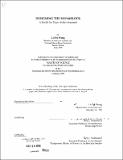Designing the superblock : a model for Taipei redevelopment
Author(s)
Wang, Li Pei
DownloadFull printable version (9.683Mb)
Other Contributors
Massachusetts Institute of Technology. Dept. of Architecture.
Advisor
Roy J. Strickland.The final section of this thesis is an implementation framework that suggests the means to realize of the redevelopment/ re-design goals. Since there currently exists no comprehensive urban design guidelines for the City of Taipei, this proposal suggests a flexible framework of design regulations that allows the design exercises in this thesis to be repeated and applied to similar blocks in the city, and to come up with different results that address the changing needs for different sites over time.
Terms of use
Metadata
Show full item recordAbstract
As many other cities in developing countries, the City of Taipei is currently confronting enormous redevelopment pressures. These pressures endanger the survival of the city's physical and social fabric. But they also offer the opportunity for the city to improve its environment. The thesis argues that these redevelopment pressures can instead be well absorbed through the strategic adoption of selective examples of traditional Taiwanese urban form. Development interventions can then be enhanced through the incorporation of successful precedents from both the local context and from abroad. Thus, the thesis presents a flexible redevelopment proposal by re-designing a typical urban super block in the City of Taipei; it illustrates the importance of historical precedents, as these may fit one or more particular situations in a Taipei super block. Both the process itself and the outcome of these prototypical design strategies should be applicable to other similar Taipei super blocks. The goal of this design of the redevelopment process is to create a super block of livability, flexibility, and feasibility. Livability is realized through the rediscovery of traditional Taiwanese urban design strategies and their adaptation to the contemporary city of Taipei. Flexibility is accomplished by offering the possibility for various redevelopment scenarios, thus evolving a complex, finegrain urban fabric. Feasibility is demonstrated by proposing a series of public actions, such as direct government interventions, redevelopment regulations and guidelines, transfer of development rights, and various incentives and disincentives that lie within the power of government today in Taipei. The thesis starts out by inspecting different aspects of the contemporary physical context of the city. Traditional urban design strategies and new urban development trends are then juxtaposed to reveal the strengths and weaknesses of both. The main body of the thesis describes the redevelopment project, which consists of a series of design strategies. A number of diagrams, ranging in scale from city-wide analyses to larger-scale studies of the super block explore various layers and aspects of urban information. These different readings serve as the foundation upon which the redesign proposals are based. Precedents from Manhattan, New York; Savannah, Georgia; and Beacon Hill and Back Bay in Boston are studied and compared to reveal the distinctive characteristics of each. Inspired by, and based on the above research, four different super block redevelopment scenarios and three housing prototypes and block consolidation approaches are put to the test as design exercises. Meanwhile, calculations of projected population, density, and demands substantiate the design proposal. On the basis of the previous steps and some general observations on the city itself, the thesis argues that making streets special "places", is a powerful organizing principle for urban design. Good paths, especially streets, do not only carry the function of traffic circulation, but also foster social interactions, commercial activities, and surprises that enrich the urban experiences. In addition, various configurations and sizes of blocks will help creating a complex, fine-grain urban environment, and will positively affect land values. Hence the redevelopment of the super block becomes primarily a street-design and blockreconfiguration project. The design of three major streets within the super block demonstrates how the public and private realms can work together and reform the physical shape of the urban environment without aggressive maneuvers, such as massive destruction, massive rebuilding, and large-scale redevelopment with highdensity tower buildings.
Description
Thesis (M.S.)--Massachusetts Institute of Technology, Dept. of Architecture, 1996.
Date issued
1996Department
Massachusetts Institute of Technology. Department of ArchitecturePublisher
Massachusetts Institute of Technology
Keywords
Architecture.